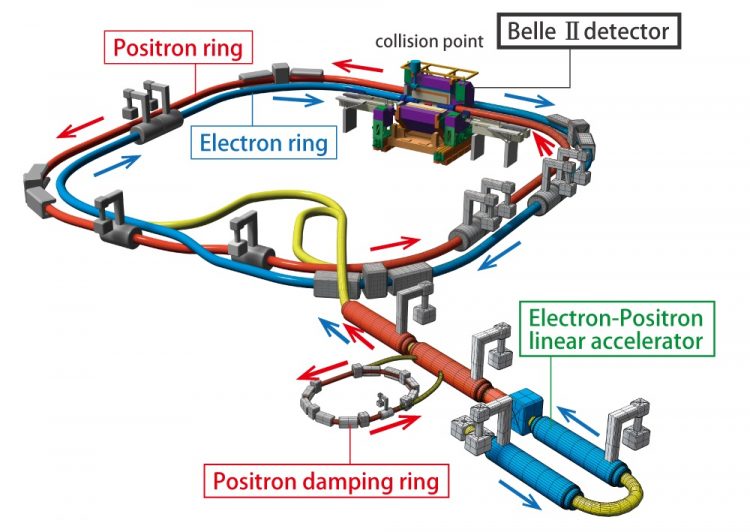First particles circulate in SuperKEKB accelerator

Plan of the SuperKEKB accelerator with the Belle-II detector ill./©: KEK
The SuperKEKB particle accelerator at the KEK research center in Japan has recently reached a major milestone: electrons and positrons have been circulated for the first time around the rings. The accelerator is now being commissioned and the start of data taking is foreseen for 2017.
One of the core questions to be investigated in these experiments is why the universe today is filled almost only with matter while in the Big Bang matter and antimatter should have been created in equal amounts. Physicists at Johannes Gutenberg University Mainz (JGU) are involved in the development of the slow-control of the detector.
The group of Professor Concettina Sfienti at the Institute of Nuclear Physics at Mainz University will be working together with some 600 scientists from 23 countries to analyze the data.
As the new accelerator is designed to deliver forty times more collisions than its predecessor KEKB, the Belle detector is also being upgraded to cope with the extreme requirements of the modified collider. The German contribution to the new Belle-II detector is a high-resolution tracker that is at the heart of the device and can very precisely record the tracks left by the generated particles. It is accurate to less than half the thickness of a human hair.
The team of physicists from Mainz provide the expertise to create the software required to monitor the detector and the readout electronics. This software is used to control the operating parameters of the detector and to continually monitor its efficiency. Although the high collision rate envisaged means that it is necessary to employ hardware that comes close to the very limits of what is feasible and is thus extremely expensive, the flip side of the coin is that this should make it possible to detect rare events.
“We have reached an important turning point in the development of the SuperKEKB, an accelerator that will have forty times the luminosity of the most powerful collider ever built. The experiment will supply us with a lot of new highly precise data which may also lead to the discovery of new particles,” said Sfienti.
Moreover, it is hoped that evidence of very rare events that may have occurred in the early phases of the creation of our universe will be discovered, providing insight into new laws of physics beyond those of the Standard Model.
Further information:
Professor Dr. Concettina Sfienti
Institute of Nuclear Physics
Johannes Gutenberg University Mainz (JGU)
55099 Mainz, GERMANY
phone +49 6131 39-25841
e-mail: sfienti@uni-mainz.de
http://www.concettinasfienti.com/
http://www.uni-mainz.de/presse/20191_ENG_HTML.php – press release ;
https://www.kek.jp/en/index.html – KEK research center ;
http://www.kek.jp/en/NewsRoom/Release/20160302163000/ – press release “First turns and successful storage of beams in the SuperKEKB electron and positron rings”, KEK
Media Contact
All latest news from the category: Physics and Astronomy
This area deals with the fundamental laws and building blocks of nature and how they interact, the properties and the behavior of matter, and research into space and time and their structures.
innovations-report provides in-depth reports and articles on subjects such as astrophysics, laser technologies, nuclear, quantum, particle and solid-state physics, nanotechnologies, planetary research and findings (Mars, Venus) and developments related to the Hubble Telescope.
Newest articles

Innovative vortex beam technology
…unleashes ultra-secure, high-capacity data transmission. Scientists have developed a breakthrough optical technology that could dramatically enhance the capacity and security of data transmission (Fig. 1). By utilizing a new type…

Tiny dancers: Scientists synchronise bacterial motion
Researchers at TU Delft have discovered that E. coli bacteria can synchronise their movements, creating order in seemingly random biological systems. By trapping individual bacteria in micro-engineered circular cavities and…

Primary investigation on ram-rotor detonation engine
Detonation is a supersonic combustion wave, characterized by a shock wave driven by the energy release from closely coupled chemical reactions. It is a typical form of pressure gain combustion,…



